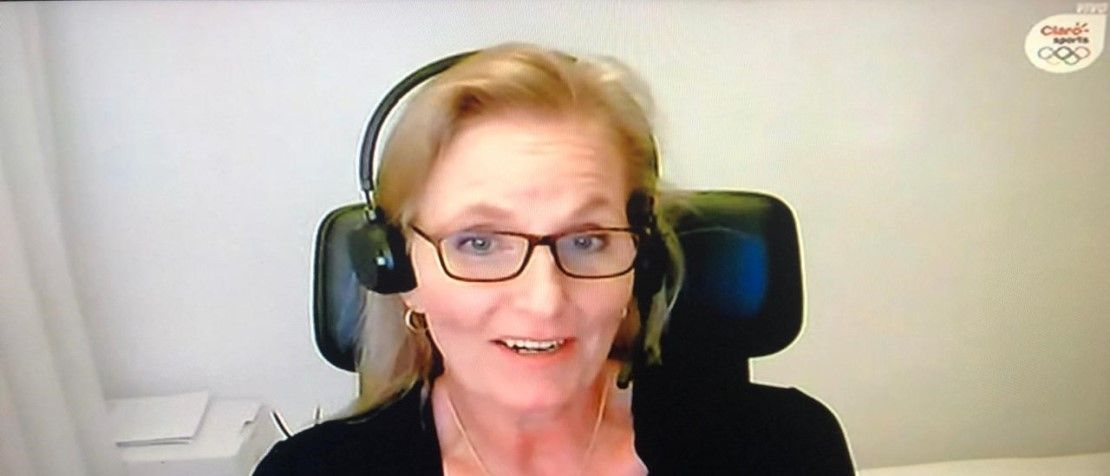
Tokyo Olympics: The most connected Games ever
Broadcasts of the 2020 Olympic Games – held in Tokyo, Japan, after a year’s delay, amid a spiralling global pandemic – have broken all kinds of records.
Beamed globally to billions of viewers, Tokyo 2020 received more coverage by broadcast partners than any previous Olympic Games in either linear or digital television formats.
While few could physically attend this time, fans worldwide experienced the emotions of the Games like never before thanks to new and innovative technologies. Olympic digital platforms attracted twice as many users compared to the last, Rio 2016, Games.
Remote commentary
As a former Olympic swimmer, I was delighted to participate in Tokyo 2020, this time as a swimming analyst. Thanks to incredible advances in broadcasting and media technologies, I felt like I was right there at poolside.
In fact, I did all my commentating remotely and safely from my home in Geneva, Switzerland, nearly 10,000 kilometres from the actual competition.

Connectivity enabled Sylvia to comment the Games despite being nearly 10,000 kilometres away from Tokyo. Image credit: Sylvia Poll.
I shared in the stunning surprise win of Tunisia’s 18-year-old swimmer Ahmed Hafnaoui, and I cried with South Africa’s Tatjana Schoenmaker, who set her first individual swimming world record at these Olympic Games.
Transported to Tokyo with tech
The International Olympic Committee (IOC) and Olympic Broadcasting Services (OBS), working with the Tokyo 2020 Organising Committee and Olympic broadcast partners, pushed the boundaries of broadcasting, to bring these Games to the world amid the COVID-19 pandemic. They produced more than 9,000 hours of content, 30 per cent more than for Rio 2016, in more formats.

Sylvia relays her analysis of the Tokyo Games from Geneva to Mexico City. Image credit: Sylvia Poll.
For the first time in Olympic history, we saw live coverage in Ultra High Definition (4K) High Dynamic Range (HDR), with immersive audio. Audiences around the world were transported with unprecedented camera angles, 360-degree replays, multi-camera live virtual reality (VR) coverage and more data processed by artificial intelligence (AI) than at any previous Olympic Games.
ICTs brought the magic of athletes’ achievements to the world on an extraordinary scale, despite COVID-19.
Technology played a critical role, enabling loved ones and sports fans to be “virtually present” inside each venue.
More than 100 million users sent 150 million virtual cheers over the Tokyo 2020 App or Olympic digital platforms. Games-related social media posts on TikTok, Instagram, Facebook, Twitter and Weibo have generated 3.7 billion engagements since the start of 2021.
Sustainable sport
Tokyo Olympics organizers took the opportunity to showcase new ideas and innovative technologies. These included moves towards creating a circular economy, in which waste and pollution are reduced while products and materials are reused and recycled.
For the first time ever, Olympic medals and podiums were produced with recycled materials.
Precious metals were extracted from small electronic devices donated by people from all over Japan to make the around 1,000 medals for Tokyo winners.
The connectivity marathon
Digital technologies let billions of people gain moments of joy and inspiration from these Olympic Games, especially after more than a year and a half of hardship and loss in the pandemic.
But not everyone could share in this key milestone for global connectivity. Worldwide, 3.7 billion people – or nearly half the planet’s population – remain unconnected to the Internet.
Everyone should have the means to be part of the Olympic experience.
In the wake of the COVID crisis, this means rapidly expanding connectivity and stepping up progress on all the Sustainable Development Goals endorsed by the United Nations.
We must build forward better, bearing in mind that we are stronger together. Sport, and the Olympic Games in particular, can serve as a model where people, nations, athletes, and teams work together to achieve common goals.
Header image credit: Sylvia Poll
